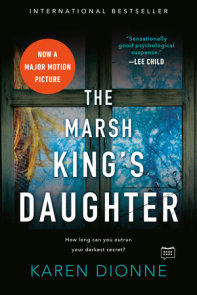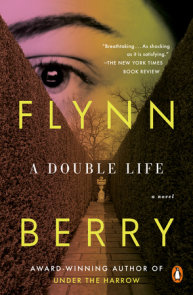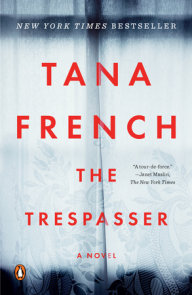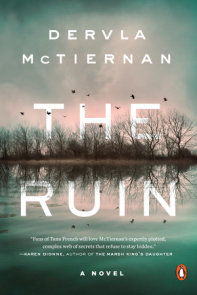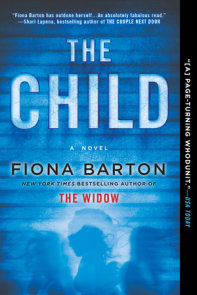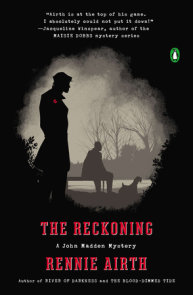READERS GUIDE
Questions and Topics for Discussion
INTRODUCTION
The follow-up to Tana French’s bestselling debut In the Woods finds Detective Cassie Maddox shaken from the events of a dangerous murder investigation and working a desk job in Domestic Violence at police headquarters in Dublin, Ireland. She’s just settling into her new suits and a quieter, if less satisfying, life when her boyfriend Detective Sam O’Neill calls her to the scene of a murder. Cassie looks at the victim, stabbed in the chest and left for dead in a ramshackle rural cottage, and finds her mirror image. Identification reveals the victim’s name is Lexie Madison—the very same handle Cassie once used as an undercover agent.
With no leads or suspects to speak of, Cassie’s boss, Frank Mackey, recognizes a unique opportunity: they can pretend that Lexie survived the stabbing and Cassie can go undercover as Lexie to solve the crime. At first, Cassie is reluctant to play along, but as she learns more about the case—and its mysterious victim—she realizes that the only way to exorcise the dead girl from her mind is to go into her life and find out what happened to her.
Posing as Lexie, Cassie becomes a graduate student at Trinity College and moves in with Lexie’s four roommates, a close but odd and anachronistic bunch sharing and rehabbing an old country estate named Whitethorn House. The roommates, accepting her story, seem to receive Lexie’s return warmly and their idyllic life is practically a vacation for Cassie. Amid the lively crew, the guarded detective, orphaned at an early age, finds an unexpected sense of belonging. Soon, though, Cassie learns that Whitethorn is the subject of local lore and a decades-long target of village hostility. And as Cassie goes deeper into Lexie’s world she realizes that Lexie’s secrets may be more dangerous than anyone imagined. Meanwhile, Frank and Sam worry that Cassie is getting a little too close to Lexie for comfort, endangering the investigation and, quite possibly, her own life in the process.
With her richly nuanced characters and deep psychological insight, Tana French explores themes of self-invention, deception, and the ways truth can emerge from even the most convincing disguises. Set against a backdrop of tightly knit class and cultural tensions, The Likeness goes beyond the conventions of the whodunit to comment on the inequities and misguided values of modern society. In her second novel, French, a seasoned actress, proves that she’s also a writer of distinction. Her taut and riveting narrative enchants and thrills at every turn.
ABOUT TANA FRENCH
Tana French is the author of the New York Times bestseller and Edgar Award–winning thriller In the Woods. She has lived in Ireland, Italy, the United States, and Malawi. She trained as a professional actress at Trinity College in Dublin, Ireland, where she lives, and has worked in film, theater, and voiceover.
A CONVERSATION WITH TANA FRENCH
Q. The Likeness picks up where your first book left off, and while the events of In the Woods inform some of the action here, this story is told from a different character’s perspective. Why did you decide to write a follow-up rather than a straight-ahead sequel?
I want to write about the crucial turning points in life, the crossroads that make all the difference; those moments when you know that once you make your choice, your life will never be in the same place it would have been if you’d chosen the other way. In the Woods was about that crucial moment in Rob Ryan’s life, but the thing is that any given lifetime just doesn’t contain all that many of those moments. So when I started thinking about my second book, I had three choices: keep dumping the poor guy into huge life-defining decisions; lower the stakes and write about less important parts of his life; or switch the narrator. I thought the last one was the most interesting, so I moved on to Cassie. I figured she deserved a book of her own anyway.
Q. Early on in the book, Cassie Maddox describes a profile of the killer. Did you consult with detectives about criminal profiling or draw on your own insight about human nature?
A little of both. Cassie isn’t a trained profiler—the Irish police force doesn’t have trained profilers; when they need one, they work with someone from the United States. or the U.K. She’s just fallen into being the Murder squad’s resident profiler by accident. Because she studied psychology in college, her colleagues use her as a fallback profiler, so she’s studied it as much as she can so as not to steer them wrong. This made it a whole lot easier for me to match her knowledge. I just did what Cassie would have done: read all the books and case studies I could get my hands on.
Profiling does involve a certain amount of basic knowledge of human nature. If a criminal takes his time at a crime scene, just for example, that implies that he’s quite comfortable there and has a high degree of confidence that he won’t be interrupted; in other words, there’s a good chance that he has prior knowledge about the location. That’s common sense. But a huge amount of profiling is based on statistics—some of them counterintuitive—about crime patterns. If the stats tell you that 95 percent of knife attacks in a certain city are committed by white males aged between sixteen and twenty, and you’re investigating a knife attack, then you know there’s a 95 percent chance that you’re looking for a teenaged white male. Real profilers build their profiles on a combination of these elements: probability based on the statistics, and intuition based on their professional experience and their knowledge of human nature. I tried to do the same with Cassie’s attempts at profiling.
Q. As an actor, do you see parallels between the process of going undercover and the process of creating or embodying a fictional character?
Definitely, but the parallels have a limit. In acting, in writing a first-person novel, and in going undercover, your goal is basically to keep out of the way as much as possible: to speak for the character, as thoroughly and deeply as possible, and let your audience see the character rather than you.
The difference is obvious, but it’s also crucial: in writing and acting, the audience isn’t intended to think that the fictional character is real. Their imaginations work together with the writer’s or actor’s to create the character; it’s a collaborative process. In undercover work, though, there’s nothing collaborative about it. The “audience” isn’t in on the process; they’re supposed to believe that the fictional character is completely real. The undercover is carefully, intently trying to deceive them, and the stakes are life and death and serious jail time. Undercover work is much darker, and much more morally charged.
Q. The idea of hiding behind another persona in order to escape a painful past is a recurring theme in this book—most obviously with Cassie and Lexie but we also see it with the other inhabitants of Whitethorn House. Is there any way in which posing as someone else can be a healthy exercise? Do you think a person has to be wounded in some sense to pull off the charade successfully?
On the contrary, actually, I think that the stronger and healthier a person is, the more likely it is that he or she can do a good job of being someone else. To go back to the acting parallel, I know some people do cling to the cliché that only damaged people become actors, and I think that’s understandable. There have always been people who see any imaginative process as deeply threatening, so they have a frantic need to say that there must be something wrong with anyone who does it. But I remember my acting teacher telling our class, Unless you can be yourself truthfully and openly, you can’t be someone else. The better you are at being yourself, the better you are at being other people. It’s true. Playing a character shouldn’t be a pose, or a charade, or a way to hide from yourself. It should be an attempt to reach a truth that can’t be reached in any other way. For any serious actor, that’s what it is. When it’s anything else, it becomes both dishonest and dangerous.
The same goes for Cassie. She’s essentially a strong, secure, happy-natured person, very comfortable being herself—that’s what makes her a good undercover, able to be someone else with conviction and sincerity. At the beginning of The Likeness, though, she’s been badly traumatized by the events of In the Woods. For her, in that condition, the process of becoming Lexie Madison is a double-edged sword. It’s healing, because by doing a good job of being Lexie she finds her feet in her own identity again; but it’s also deeply dangerous, because her own borderlines have been damaged so badly that she’s not grounded enough to stop herself blurring into Lexie. And Lexie isn’t a particularly healthy person to blur into.
Q. Did you know when you first set out with this book who the murderer was or was that a discovery you made as you wrote?
Here’s the defining fact about my writing process: I have no clue what I’m doing. I start with a narrator, a kernel of a premise, and a whole lot of coffee. From there, I just dive in and hope.
I think it’s because I’m coming from an acting background. I’m used to taking characters as my starting point, and when I start on a book, I don’t know the characters well enough to know what they would do, where they’re coming from or where they’re headed. As I get to know them better, the shape of the book develops gradually in my head, like a Polaroid. (It makes for an awful lot of rewriting. I’m wildly jealous of authors who have the whole book outlined before they ever start writing.) When I started this book, I had no idea who the victim was or why the heck anyone would want to kill her, never mind who the killer was. As the characters and their relationships developed, though, it became clear that Lexie Madison could be a lot more dangerous than she looked and that whether she intended to or not, she was threatening the people around her in a variety of ways—and, finally, which one of those people was capable of taking the huge leap to murder.
Q. There’s an undercurrent of class conflict and English/Irish hostility bubbling beneath the plot in this novel. Are these issues necessary to the telling of this particular story or are they simply part of the rural Irish landscape in which it’s set?
I think they’re an inextricable part of the story. They’re a crucial part of Ireland’s past, and one of the core things I was thinking about while I wrote this book is the relationship between past, present and future: how they define and redefine one another, how we try and often fail to balance the three.
This is, I think, the major question that Ireland’s dealing with right now: when the past and the present crash into each other at a hundred miles an hour, how do you balance the two without wrecking both? Over the past ten or fifteen years, the country’s changed faster than our minds can deal with, and we’re still trying to assimilate the changes and find healthy ways of dealing with them. Because this is a question that surrounds me every day, it surfaced in the book: all the characters are trying, from different angles, to find ways to balance past, present and future. The house’s past, and Ireland’s past, are woven into that process.
Q. Whitethorn House has a powerful effect on people—it is wondrous and inspiring to its inhabitants but malevolent and threatening to the townsfolk of Glenskehey. In many of your descriptions the house is animated and alive. Do you think of the house as a character in its own right?
Definitely, but it’s a fluid character, one that’s defined by the other characters and defined differently by each one. It becomes a mirror reflecting what they want or need to see—it’s a home, a haven, a threat, an inspiration, a symbol of oppression, a golden opportunity. In that way, it’s a lot like Lexie herself. She puts her finger on what each of the other characters needs to see, and then she turns herself into that.
Q. Troubled though he may be, Daniel makes an eloquent argument when he critiques contemporary culture and tells Cassie about his vision for Whitethorn House. Do you agree with his views and is this an important theme in your writing?
I don’t exactly agree with Daniel—he’s a little extreme, if that’s the word I’m looking for—but I think he has a couple of good points. At one stage he quotes a Spanish proverb: “Take what you want and pay for it, says God.”
That proverb’s a lot more complicated than it sounds. We’re surrounded by media and other outside forces telling us what we want: You want more stuff! You want bigger stuff! You want stuff you’ve never even heard of! You want an SUV and new teeth and 2.4 kids! You want to be thinner! You want to be blonder! And on and on and on. It can be hard to ignore all the shouting and figure out what you actually want—which might well be none of the above. And if you don’t know, if you allow yourself to be shaped by other people’s views on what you should want, then it’s dangerously easy to lose hold of your own life. For Daniel, that’s one of the two core elements of being an adult: the ability to work out what you want most.
And in the proverb, that crucial question comes with an equally crucial corollary: what you want isn’t free. The other thing we get told an awful lot in Western society is that you can have anything as long as you believe in it. There’s no mention of having to pay for it—with hard work, with sacrifices, whatever. And the reality is that life does demand payment. Choose between the security of a bank job and your dream of being a musician; choose between staying home with your children or keeping your career moving. Whichever you choose, you pay for it with the other. It’s a law of nature, it’s one we’re told to ignore, and it’s one that we can’t escape no matter how hard we try.
For Daniel, the two essentials of being an adult human being are knowing what you want and making the commitment to pay for it. What he wants may be a little weird, but he does know what it is, and he’s certainly willing to pay for it.
Q. There’s not a single sex scene in this book yet between the lines, sexual relationships deeply influence the dynamic between characters. Was it a conscious decision for you to keep sex as subtext in this book?
Part of it was a deliberate choice. I’m not big on spelling things out anyway. I think almost everything—especially powerful stuff like sex and violence—is stronger if it’s not hammered home, if the reader is allowed to engage his or her imagination. In In the Woods, the most violent thing that happens “onstage” is someone scratching someone else’s face. In The Likeness, the most sexually explicit thing that happens is a kiss.
And part of it was inherent to the book. There’s a stage in life, somewhere around high school and college, when the most important people in your world are your friends. You’re moving away from your original family, but you’re not yet at the age when people are forming lifelong romantic relationships—one of the gang might get a boyfriend or girlfriend and fade away for a couple of months, but everyone knows he’ll be back sooner or later. The crucial people are this group of friends, some of them close, some of them a little less close, who surround you.
That’s the stage the main characters in this book are at. They’re one another’s world. And at that stage, sex within the group is a dangerous thing: it could wreck your whole delicate, hard-won balance. So, no matter how highly charged those relationships get, the characters fight to hide the sexual tension from each other and even from themselves. Sex is kept to subtext in the book because it’s kept to subtext by the characters—with an immense effort of will that comes at a high price.
Q. The fact that Lexie Madison looks exactly like Cassie and steals her undercover identity is something of an improbable premise. How did you take a fanciful idea and turn it into a believable story?
I knew from the start that I’d bitten off a lot with that premise—the dubious look on my fiancé’s face when I told him the idea said it all! But I like a challenge. And I loved the image of the detective looking down at her own dead face, the thought of finding your double when it’s too late, when she’s beyond reach—when the only way to get to know her is to become her. I didn’t want to ditch the idea. I was too interested in finding out what would happen next. So I knew I had to find a way to make it work.
I did it (well, I hope I did it!) by focusing on the same things Cassie and Frank would have had to focus on as they prepared for the moment when Cassie goes into Lexie’s life: the practical details, the nuances of personal relationships, all the layers that go into making up a solid, believable reality. Also, Lexie stealing Cassie’s undercover identity doesn’t turn out to be quite as much of a coincidence as it originally appears.
DISCUSSION QUESTIONS
Early on in the book, Cassie Maddox says that “all the best undercovers have a dark thread woven into them, somewhere.” What is hers?
For Cassie, going undercover is almost a compulsion. What drives her to accept Frank’s offer and take on Operation Mirror?
The rule at Whitethorn House is “no pasts,” yet the house is seeped in history and artifacts from earlier eras. How does the house help its inhabitants avoid their own histories?
Undercover, Cassie slowly gets drawn into life at Whitethorn House and develops a fondness for Lexie’s idiosyncratic housemates. What is it about this world that is so enchanting for her?
Cassie says this is Lexie Madison’s story, not hers, yet she tells it like it’s her own. Whose story do you think it is?
Commitment is an issue for Cassie, as she can’t seem to settle down with a desk job or her boyfriend. At the same time, she has chosen to work undercover and devote her every hour to this case—a very serious commitment of a different kind. Is this a contradiction in her personality, or are they complementary behaviors?
Daniel, Abby, Rafe, Justin, and Lexie’s relationship is a fascinating study of group dynamics and each character plays a distinct role. Just as Lexie did before her, Cassie can home in on who she needs to be to fit in. Do you think this is something most people do in social situations or is it a special skill?
What does posing as Lexie teach Cassie about herself? What are the differences between the two characters and where does Cassie draw the line?
Cassie wonders if Frank Mackey may have had a stronger hunch about the killer than he was admitting all along. Do you think he knew who the killer was?
French leaves the story of what happened the night of the stabbing somewhat open. What do you think really happened to Lexie and who was truly responsible?









